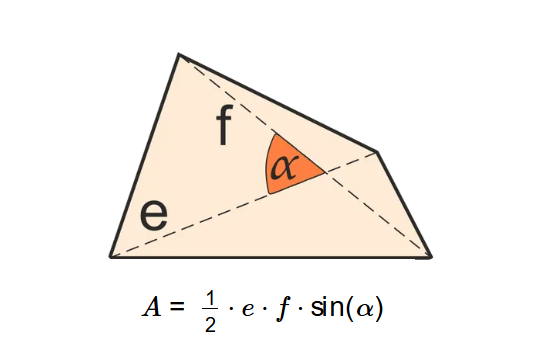1. What is an Area of a Quadrilateral Calculator?
Definition: This calculator computes the area of a quadrilateral using four methods: Diagonals and Angle Between, Bimedians and Angle Between, 4 Sides and Two Opposite Angles, and Cartesian Coordinates of Vertices. It also calculates the perimeter for the latter two methods. The calculator supports length units (mm, cm, m, in, ft, yd) and area units (mm², cm², m², in², ft², yd²), defaulting to m for inputs and lengths, and m² for area.
Purpose: It aids in geometry education and practical applications by calculating key properties of quadrilaterals, useful in fields like architecture, engineering, and design for shapes like rooms, plots, or panels.
2. How Does the Calculator Work?
The calculator uses the following methods:
- Diagonals and Angle Between:
- Area: \( A = \frac{1}{2} \cdot e \cdot f \cdot \sin(\alpha) \)
- Bimedians and Angle Between:
- Area: \( A = k \cdot m \cdot \sin(\theta) \)
- 4 Sides and Two Opposite Angles:
- Semi-perimeter: \( s = \frac{a + b + c + d}{2} \)
- Area: \( A = \sqrt{(s-a)(s-b)(s-c)(s-d) - abcd \cdot \cos^2\left(\frac{\delta + \gamma}{2}\right)} \)
- Perimeter: \( P = a + b + c + d \)
- Cartesian Coordinates of Vertices:
- Area: \( A = \frac{1}{2} \left| x_1(y_2 - y_4) + x_2(y_3 - y_1) + x_3(y_4 - y_2) + x_4(y_1 - y_3) \right| \)
- Perimeter: Sum of distances between consecutive vertices.
Steps:
- Select the calculation method.
- Input the required values, with length units defaulting to m.
- Select the desired output units for area and perimeter (defaulting to m² and m).
- Validate inputs: ensure lengths are positive, angles are valid, and the quadrilateral can exist.
- Convert all lengths to meters for calculation.
- Compute the area and perimeter using the selected method.
- Convert the results to the selected units.
- Display results with lengths and area to 4 decimal places.
3. Importance of Quadrilateral Area Calculations
Quadrilateral calculations are essential for:
- Geometry: Understanding properties of quadrilaterals, which are common shapes in mathematical problems.
- Architecture: Designing rooms or structures with quadrilateral footprints, often requiring unit conversions (e.g., m² to ft²).
- Surveying: Calculating areas of quadrilateral land plots using coordinates or side measurements.
4. Using the Calculator
Examples:
- Diagonals and Angle Between: \( \alpha = 60^\circ \), \( e = 4 \) m, \( f = 6 \) m, Area in m²
Area: \( A = \frac{1}{2} \cdot 4 \cdot 6 \cdot \sin(60^\circ) \approx 10.3923 \) m².
- Bimedians and Angle Between: \( \theta = 90^\circ \), \( k = 5 \) m, \( m = 3 \) m, Area in m²
Area: \( A = 5 \cdot 3 \cdot \sin(90^\circ) = 15.0000 \) m².
- 4 Sides and Two Opposite Angles: Sides \( a = 100 \) cm, \( b = 60 \) cm, \( c = 80 \) cm, \( d = 50 \) cm, \( \delta = 70^\circ \), \( \gamma = 110^\circ \), Area in cm², Perimeter in mm
Convert to meters: \( a = 1 \) m, \( b = 0.6 \) m, \( c = 0.8 \) m, \( d = 0.5 \) m
Semi-perimeter: \( s = \frac{1 + 0.6 + 0.8 + 0.5}{2} = 1.45 \)
Area: \( A = \sqrt{(1.45-1)(1.45-0.6)(1.45-0.8)(1.45-0.5) - 1 \cdot 0.6 \cdot 0.8 \cdot 0.5 \cdot \cos^2\left(\frac{70 + 110}{2}\right)} \approx 0.4136 \) m² = 4136.0000 cm²
Perimeter: \( P = 1 + 0.6 + 0.8 + 0.5 = 2.9000 \) m = 2900.0000 mm.
- Cartesian Coordinates: \( (x_1, y_1) = (0, 0) \) m, \( (x_2, y_2) = (4, 0) \) m, \( (x_3, y_3) = (5, 3) \) m, \( (x_4, y_4) = (1, 2) \) m, Area in m², Perimeter in m
Area: \( A = \frac{1}{2} \left| 0(0-2) + 4(3-0) + 5(2-0) + 1(0-3) \right| = \frac{1}{2} \left| 12 + 10 - 3 \right| = 9.5000 \) m²
Perimeter: \( d_{12} = 4 \), \( d_{23} = \sqrt{(5-4)^2 + (3-0)^2} \approx 3.1623 \), \( d_{34} = \sqrt{(1-5)^2 + (2-3)^2} \approx 4.1231 \), \( d_{41} = \sqrt{(0-1)^2 + (0-2)^2} \approx 2.2361 \)
\( P = 4 + 3.1623 + 4.1231 + 2.2361 \approx 13.5215 \) m.
5. Frequently Asked Questions (FAQ)
Q: What is a quadrilateral?
A: A quadrilateral is a four-sided polygon, such as a square, rectangle, or trapezoid. It can be convex or concave, and its area can be calculated using various methods depending on the given data.
Q: Why do inputs and outputs default to m and m²?
A: Meters (m) and square meters (m²) are the default units to provide a standard metric base, ensuring consistency in calculations, but you can convert to other units as needed.
Q: What are bimedians?
A: Bimedians are line segments connecting the midpoints of opposite sides of a quadrilateral. Their lengths and the angle between them can be used to calculate the area.
Area of a Quadrilateral Calculator© - All Rights Reserved 2025
 Home
Home
 Back
Back
